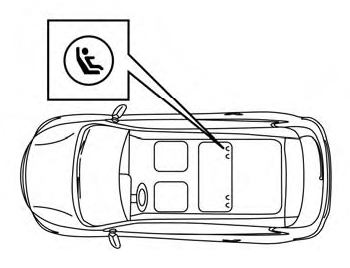Nissan Murano: Changing wheels and tires / Tire rotation

NISSAN recommends rotating the tires every 5,000 miles (8,000 km).
For additional information on tire replacing procedures, refer to “Flat tire” in the “In case of emergency” section of this manual.
As soon as possible, tighten the wheel nuts to the specified torque with a torque wrench.
Wheel nut tightening torque:
83 ft-lb (113 N·m)
The wheel nutsmustbe kept tightened to specifications at all times. It is recommendedthat wheel nuts be tightened to specification at each tire rotation interval.
WARNING
- After rotating the tires, check and adjust the tire pressure.
- Retighten the wheel nuts when the vehicle has been driven for 600 miles (1,000 km) (also in cases of a flat tire, etc.).
- Do not include the spare tire in the tire rotation.
- For additional information regarding tires, refer to “Important Tire Safety Information” (US) or “Tire Safety Information” (Canada) in the Warranty Information Booklet.
 Tire wear and damage
Tire wear and damage
Wear indicator
Location mark
WARNING
Tires should be periodically inspected
for wear, cracking,
bulging or objects caught in the
tread. If excessive wear, cracks,
bulging or deep cuts are found,
the tire(s) should be replaced...
Other information:
Nissan Murano (Z52) 2015-2024 Service Manual: U0300 Can Communication Data
DTC Description DTC DETECTION LOGICWhen the ignition switch is ON, the data length transmitted from each control unit is shorter than the specified length and the status continues for 2 seconds or more. DTC CONSULT screen terms (Trouble diagnosis content) DTC detection condition U0300 CAN COMM DATA (Internal Control Module Software Incompatibility) Diagnosis condition When the ignition switch is ON Signal CAN communication data Threshold The data length transmitted from each control unit is shorter than the specified length and the status Diagnosis delay time Continues for 2 seconds or more POSSIBLE CAUSEControl unit other than TCMFAIL-SAFE Selector shock is large Start is slow Acceleration is slow Lock-up is not performed DTC Confirmation Procedure PREPARATION BEFORE WORK If another “DTC CONFIRMATION PROCEDURE” occurs just before, turn ignition switch OFF and wait for at least 10 seconds, then perform the next test...
Nissan Murano (Z52) 2015-2024 Service Manual: Glass & Window System :: Symptom Diagnosis. Squeak and Rattle Trouble Diagnoses
Work Flow CUSTOMER INTERVIEWInterview the customer if possible, to determine the conditions that exist when the noise occurs. Use the Diagnostic Worksheet during the interview to document the facts and conditions when the noise occurs and any customer's comments; refer to Diagnostic Worksheet...
Categories
- Manuals Home
- Nissan Murano Owners Manual
- Nissan Murano Service Manual
- Checking engine oil level
- Passenger compartment
- Vehicle Dynamic Control (VDC) OFF switch
- New on site
- Most important about car
LATCH (Lower Anchors and Tethers for CHildren) system

LATCH system lower anchor locations - bench seat
Your vehicle is equipped with special anchor points that are used with LATCH system compatible child restraints. This system may also be referred to as the ISOFIX or ISOFIX compatible system. With this system, you do not have to use a vehicle seat belt to secure the child restraint unless the combined weight of the child and child restraint exceeds 65 lbs. (29.5 kg). If the combined weight of the child and child restraint is greater than 65 lbs. (29.5 kg), use the vehicle’s seat belt (not the lower anchors) to install the child restraint. Be sure to follow the child restraint manufacturer’s instructions for installation.

